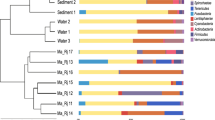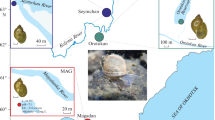Abstract
The first results of a study into the microbiomes of benthic invertebrates found in sites with seeps (containing methane, oil, or a combination of methane and mud) and an underwater low-temperature vent of Lake Baikal are presented. Microorganisms were detected in the intestine of an oligochaete from the cold methane seep using microscopy. Analysis of 16S rRNA gene libraries revealed that the highest diversity of microorganisms was found in the nematode microbiomes where the members of 11 phyla were identified. Some of the detected prokaryotes are methanogens, nitrifiers, and nitrogen fixators, while some are involved in the sulfur cycle. Methanotrophs were detected in the microbiomes of oligochaetes and chironomids. The microbiomes of nematodes, chironomids, and bathynellids are composed of members of the Bacteroidetes and Firmicutes phyla, which are related to the symbiotic bacteria found in insects and animals from other ecotopes. Microorganisms typically found in the water and sediments of Lake Baikal were also detected in the invertebrates microbiomes.






Similar content being viewed by others
References
Dick GJ (2019) The microbiomes of deep-sea hydrothermal vents: distributed globally, shaped locally. Nat Rev Microbiol 17:271–283. https://doi.org/10.1038/s41579-019-0160-2
DeChaine EG, Cavanaugh CM (2005) Symbioses of methanotrophs and deep-sea mussels (Mytilidae: Bathymodiolinae). In: Overmann J (ed) Molecular basis of symbiosis progress in molecular and subcellular biology, vol 4. Springer, Berlin, pp 227–249
Beinart RA (2019) The significance of microbial symbionts in ecosystem processes. mSystems. https://doi.org/10.1128/mSystems.00127-19
Goffredi SK, Jones WJ, Erhlich H, Springer A, Vrijenhoek RC (2008) Epibiotic bacteria associated with the recently discovered Yeti crab, Kiwa hirsute. Environ Microbiol 10:2623–2634. https://doi.org/10.1111/j.1462-2920.2008.01684.x
Ponnudurai R, Kleiner M, Sayavedra L, Petersen JM, Moche M, Otto A, Becher D, Takeuchi T, Satoh N, Dubilier N, Schweder T, Markert S (2017) Metabolic and physiological interdependencies in the Bathymodiolus azoricus symbiosis. ISME J 11:463–477. https://doi.org/10.1038/ismej.2016.124
Fiore CL, Jarett JK, Olson ND, Lesser MP (2010) Nitrogen fixation and nitrogen transformations in marine symbioses. Trends Microbiol 18:455–463. https://doi.org/10.1016/j.tim.2010.07.001
Burnett WJ, McKenzie JD (1997) Subcuticular bacteria from the brittle star Ophiactis balli (Echinodermata: Ophiuroidea) represent a new lineage of extracellular marine symbionts in the alpha subdivision of the class Proteobacteria. Appl Environ Microbiol 63:1721–1724. https://doi.org/10.1128/AEM.63.5.1721-1724.1997
Takacs-Vesbach C, King K, Van Horn D, Larkin K, Neiman M (2016) Distinct bacterial microbiomes in sexual and asexual Potamopyrgus antipodarum, a New Zealand freshwater Snail. PLoS ONE 11(8):e0161050. https://doi.org/10.1371/journal.pone.0161050
Flot JF, Wörheide G, Dattagupta S (2010) Unsuspected diversity of Niphargus amphipods in the chemoautotrophic cave ecosystem of Frasassi, central Italy. BMC Evolut Biol 10:171. https://doi.org/10.1186/1471-2148-10-171
Mioduchowska M, Czyż MJ, Gołdyn B, Kilikowska A, Namiotko T, Pinceel T, Laciak M, Sell J (2018) Detection of bacterial endosymbionts in freshwater crustaceans: the applicability of non-degenerate primers to amplify the bacterial 16S rRNA gene. PeerJ 6:e6039. https://doi.org/10.7717/peerj.6039
Granina LZ (2008) Early diagenesis of bottom sediments in Lake Baikal. Academic Publishing House Geo, Novosibirsk
Namsaraev BB, Dulov LE, Dubinina GA, Zemskaya TI, Granina LZ, Karabanov EV (1994) Participation of bacteria in processes of synthesis and destruction of organic matter in microbial mats of the Lake Baikal. Microbiology 63:344–351
Sitnikova TY, Shirokaya AA (2013) New data on deep-water Baikal limpets found in hydrothermal vents and oil-seeps. Archiv fuer Molluskenkd 142:257–278. https://doi.org/10.1127/arch.moll/1869-0963/142/257-278
Klerkx J, Zemskaya TI, Matveeva TV, Khlystov OM, Namsaraev BB, Dagurova OP, Golobokova LP, Vorob’yova SS, Pogodaeva TP, Granin NG, Kalmichkov GV, Ponomarchuk VA, Shodgi H, Mazurenko LL, Kaulio VV, Solov’yov VA, Grachev MA (2003) Methane hydrates in deep bottom sediments of Lake Baikal. Dokl Earth Sci 393:822–826
Sitnikova T, Kiyashko S, Bukshuk N, Zemskaya T, Khlystov O, Moore MV (2016) Stable isotope signatures and distribution of deepwater sponges in Lake Baikal. Hydrobiologia 773:11–22. https://doi.org/10.1007/s10750-016-2674-1
Cabello-Yeves PJ, Zemskaya TI, Zakharenko AS, Sakirko MV, Ivanov VG, Ghai R, Rodriguez-Valera F (2020) Microbiome of the deep Lake Baikal, a unique oxic bathypelagic habitat. Limnol Oceanogr 65:1471–1488. https://doi.org/10.1002/lno.11401
Tulupova YuR, Parfenova VV, Sitnikova TYa, Sorokovnikova EG, Khanaev IB (2012) First report on bacteria of the family Spirochaetaceae from digestive tract of endemic gastropods from Lake Baikal. Microbiology 81:500–507. https://doi.org/10.1134/S0026261712030150
Maximenko SYu, Zemskaya TI, Naumova YuYu, Melnik NG (2008) Analysis of the microbial community of the stomach of the Baikal endemic Epischura baicalensis using the method of fluorescence in situ hybridization. Hydrobiol J 44:78–82. https://doi.org/10.1615/HydrobJ.v45.i1.60
Khalzov IA, MekhanikovaSitnikova IVTYa (2018) First data on ectosymbiotic consortia of infusoria and prokaryotes associated with amphipods inhabiting the Frolikha underwater hydrothermal vent, lake Baikal. Zool zhurnal 97:1525–1530. https://doi.org/10.1134/S0044513418120073
Denisova LYa, Bel’kova NL, Tulokhonov II, Zaichikov EF (1999) Bacterial diversity at various depth in the southern part of lake Baikal as revealed by 16S rDNA sequencing. Microbiology 68:475–483
Hallam SJ, Girguis PR, Preston CM, Richardson PM, DeLong EF (2003) Identification of methyl coenzyme M reductase A (mcrA) genes associated with methane-oxidizing archaea. Appl Environ Microbiol 69:543–549. https://doi.org/10.1128/AEM.69.9.5483-5491.2003
Muyzer G, Teske A, Wirsen CO (1995) Phylogenetic relationships of Thiomicrospira species and their identification in deep-sea hydrothermal vent samples by denaturing gradient gel electrophoresis of 16S rDNA fragments. Arch Microbiol 164:165–172
Chernitsyna SM, Mamaeva EV, Lomakina AV, Pogodaeva TV, Galach’yants YuP, Bukin SV, Pimenov NV, Khlystov OM, Zemskaya TI (2016) Phylogenetic diversity of microbial communities of the Posolsk Bank bottom sediments, Lake Baikal. Microbiology 85:652–662. https://doi.org/10.1134/S0026261716060060
Zakharova YuR, Kurilkina MI, Likhoshvay AV, Shishlyannikov SM, Kalyuzhnaya OV, Petrova DP, Likhoshway EV (2013) Effect of bacteria from the bottom water layer of Lake Baikal on degradation of diatoms. Paleontol J 47(9):1030–1034. https://doi.org/10.1134/S0031030113090256
Zemskaya TI, Lomakina AV, Shubenkova OV, Pogodaeva TV, Morozov IV, Chernitsina SM, Sitnikova TY, Khlystov OM, Egorov AV (2015) Jelly-like microbial mats over subsurface fields of gas hydrates at the St. Petersburg methane seep (Central Baikal). Geomicrobiol J 32:89–100. https://doi.org/10.1080/01490451.2014.910572
Lapteva IA (1987) Environmental features of the distribution of bacteria Caulobacter genus in fresh water basins. Microbiology 56:677–684
Galach’yants AD, Bel’kova NL, Sukhanova EV, Galach’yants YP, Morozova AA, Parfenova VV (2017) Taxonomic composition of Lake Baikal bacterioneuston communities. Microbiology 86:241–249. https://doi.org/10.1134/S0026261717020084
Cabello-Yeves PJ, Zemskaya TI, Rosselli R, Coutinho FH, Zakharenko AS, Blinov VV, Rodriguez-Valera F (2018) Genomes of novel microbial lineages assembled from the sub-ice waters of Lake Baikal. Appl Environ Microbiol 84:e02132-e2217. https://doi.org/10.1128/AEM.02132-17
Kasalický V, Jezbera J, Hahn MW, Šimek K (2013) The diversity of the Limnohabitans genus, an important group of freshwater bacterioplankton, by characterization of 35 isolated strains. PLoS ONE 8:e58209. https://doi.org/10.1371/journal.pone.0058209
Popovskaya GI, Belykh OI (2003) Stages of studying the autotrophic picoplankton of Lake Baikal. Hydrobiol J 39:12–24
Santoro AE, Richter RA, Dupont CL (2019) Planktonic marine Archaea. Annu Rev Mar Sci 11:131–158. https://doi.org/10.1146/annurev-marine-121916-063141
Naumova TV, Sitnikova TY, Gagarin VG (2012) The species composition and distribution of free-living Nematodes (Nematoda) in an area of natural oil and gas seeps in Lake Baikal. Inland Water Biol 5:161–168. https://doi.org/10.1134/S1995082912020113
Motoki K, Watsuji T, Takaki Y, Takai K, Iwasaki W (2020) Metatranscriptomics by in situ RNA stabilization directly and comprehensively revealed episymbiotic microbial communities of deep-sea squat lobsters. mSystems 5:e00551-e620. https://doi.org/10.1128/mSystems.00551-20
Worthen PL, Gode CJ, Graf J (2006) Culture-independent characterization of the digestive-tract microbiota of the medicinal leech reveals a tripartite symbiosis. AEM 72:4775–4781. https://doi.org/10.1128/AEM.00356-06
Gotoh T, Noda H, Ito S (2007) Cardinium symbionts cause cytoplasmic incompatibility in spider mites. Heredity 98:13–20. https://doi.org/10.1038/sj.hdy.6800881
Zemskaya TI, Sitnikova TY, Kiyashko SI, Kalmychkov GV, Pogodaeva TV, Mekhanikova IV, Naumova TV, Shubenkova OV, Chernitsina SM, Kotsar OV, Chernyaev ES, Khlystov OM (2012) Faunal communities at sites of gas- and oil-bearing fluids in Lake Baikal. Geo-Mar Lett 32:437–451. https://doi.org/10.1007/s00367-012-0297-8
Sitnikova TYa, Mekhanikova IV, Sideleva VG, Kiyashko SI, Naumova TV, Zemskaya TI, Khlystov OM (2017) Trophic relationships between macroinvertebrates and fish in St. Petersburg methane seep community in abyssal zone of Lake Baikal. Contemp Probl Ecol 10:147–156. https://doi.org/10.1134/S1995425517020123
Vanreusel A, Andersen A, Boetius A, Connelly D, Cunha M, Decker C, Hilario A, Kormas KA, Maignien L, Olu K, Pachiadaki M, Ritt B, Rodrigues C, Sarrazin J, Tyler P, Van Gaever S, Vanneste H (2009) Biodiversity of cold seep ecosystems along the European margins. Oceanography 22:110–127. https://doi.org/10.5670/oceanog.2009.12
Kaygorodova IA (2011) Deep-water fauna of Oligochaeta (Annelida, Clitellata) near hydrothermal spring of the Frolikha Bay, Northern Baikal (East Siberia, Russia). J Siberian Federal Univ Biol 2(4):117–132. https://doi.org/10.17516/1997-1389-0175
Levin LA, Michener RH (2002) Isotopic evidence for chemosynthesis-based nutrition of macrobenthos: the lightness of being at Pacific methane seeps. Limnol Oceanogr 47:1336–1345. https://doi.org/10.4319/lo.2002.47.5.1336
Goffredi SK, Tilic E, Mullin SW, Dawson KS, Keller A, Lee RW, Wu F, Levin LA, Rouse GW, Cordes EE, Orphan VJ (2020) Methanotrophic bacterial symbionts fuel dense populations of deep-sea feather duster worms (Sabellida, Annelida) and extend the spatial influence of methane seepage. Sci Adv 6(14):eaay8562. https://doi.org/10.1126/sciadv.aay8562
Jones R, Grey J (2011) Biogenic methane in freshwater food webs. Freshwater Biol 56:213–229. https://doi.org/10.1111/j.1365-2427.2010.02494.x
Jones SE, Lennon JT (2009) Evidence for limited microbial transfer of methane in a pelagic food web. Aquat Microb Ecol 58:45–53. https://doi.org/10.3354/ame01349
Leak DJ, Stanley SH, Dalton H (1985) Implication of the nature of methane monooxygenase on carbon assimilation in methanotrophs. In: Poole RK, Dow CS (eds) Microbial gas metabolism, mechanistic, metabolic and biotechnological aspects. Academic Press, London, pp 201–208
Graham DW, Chaudhary JA, Hanson RS, Arnold RG (1993) Factors affecting competition between type I and type II methanotrophs in continuous-flow reactors. Microb Ecol 25:1–17. https://doi.org/10.1007/BF00182126
Raghoebarsing A, Smolders A, Schmid M, Rijpstra W, Wolters-Arts M, Derksen J, Jetten M, Schouten S, Damsté J, Lamers L, Roelofs J, den Camp H, Strous M (2005) Methanotrophic symbionts provide carbon for photosynthesis in peat bogs. Nature 436:1153–1156. https://doi.org/10.1038/nature03802
Mekhanikova IV, Sitnikova TYa (2014) Amphipods (Amphipoda, Gammaridea) at the Gorevoy Utes oil and methane seep, Lake Baikal. Crustaceana 87:1500–1520. https://doi.org/10.1163/15685403-00003367
Lazo FI (1980) Sulfur geochemistry in the bottom sediments of Lake Baikal. Geochemistry 1:109–115
Friedrich CG, Bardischewsky F, Rother D, Quentmeier A, Fischer J (2005) Prokaryotic sulfur oxidation. Curr Opin Microbiol 8:253–259. https://doi.org/10.1016/j.mib.2005.04.005
Zemskaya TI, Namsaraev BB, Dul’tseva NM, Khanaeva TA, Golobokova LP, Dubinina GA, Dulov LE, Wada E (2001) Ecophysiological characteristics of the mat-forming bacterium Thioploca in bottom sediments of the Frolikha Bay, Northern Baikal. Microbiology 70:335–341
Newton RJ, Jones SE, Eiler A, McMahon KD, Bertilsson S (2011) A guide to the natural history of freshwater lake bacteria. Microb Mol Biol Rev 75:14–49. https://doi.org/10.1128/MMBR.00028-10
Moeller FU, Webster NS, Herbold CW, Behnam F, Domman D, Albertsen M, Mooshammer M, Markert S, Turaev D, Becher D, Rattei T, Schweder T, Richter A, Watzka M, Nielsen PH, Wagner M (2019) Characterization of a thaumarchaeal symbiont that drives incomplete nitrification in the tropical sponge Ianthella basta. Environ Microbiol 21:3831–3854. https://doi.org/10.1111/1462-2920.14732
Vuillemin A, Wankel SD, Coskun ÖK, Magritsch T, Vargas S, Estes ER, Spivack AJ, Smith DC, Pockalny R, Murray RW, D’Hondt S, Orsi WD (2019) Archaea dominate oxic subseafloor communities over multimillion-year time scales. Sci Adv 5:4108. https://doi.org/10.1126/sciadv.aaw4108
Acknowledgements
The State Assignment 0279-2021-0006 supported the work. Microscopic studies were carried out in the Electronmicroscopy center of collective instrumental center “Ultramicroanalysis” Limnological Institute Siberian Branch of the Russian Academy of Sciences (http://www.lin.irk.ru/).
Author information
Authors and Affiliations
Contributions
TZ and TS designed the research and revised the manuscript; SC wrote the manuscript; AK, TS, and TN performed samples; IK did microscopy; SC did molecular analysis. All authors read and approved the final manuscript.
Corresponding author
Ethics declarations
Conflict of interest
The authors declare no conflict of interests.
Additional information
Publisher's Note
Springer Nature remains neutral with regard to jurisdictional claims in published maps and institutional affiliations.
Supplementary Information
Below is the link to the electronic supplementary material.
Rights and permissions
About this article
Cite this article
Chernitsyna, S.M., Khalzov, I.A., Sitnikova, T.Y. et al. Microbial Communities Associated with Bentic Invertebrates of Lake Baikal. Curr Microbiol 78, 3020–3031 (2021). https://doi.org/10.1007/s00284-021-02563-0
Received:
Accepted:
Published:
Issue Date:
DOI: https://doi.org/10.1007/s00284-021-02563-0




